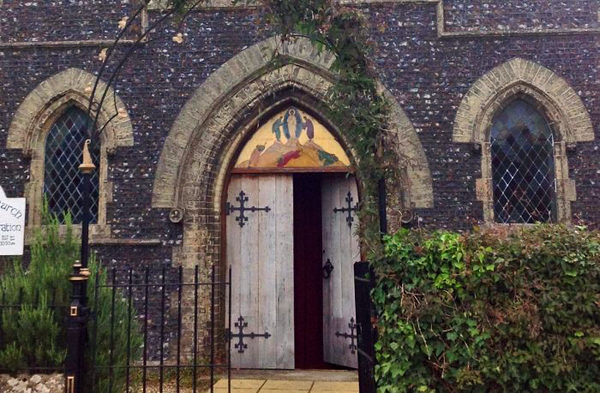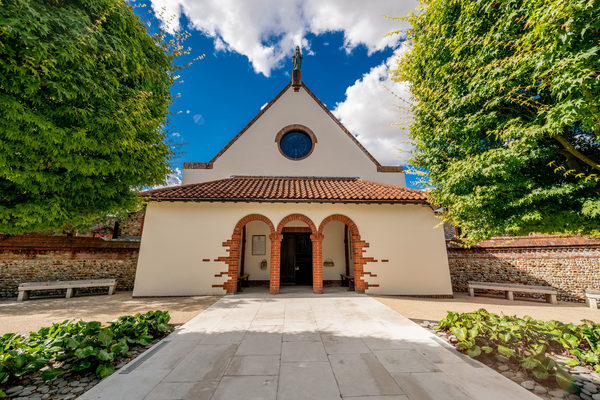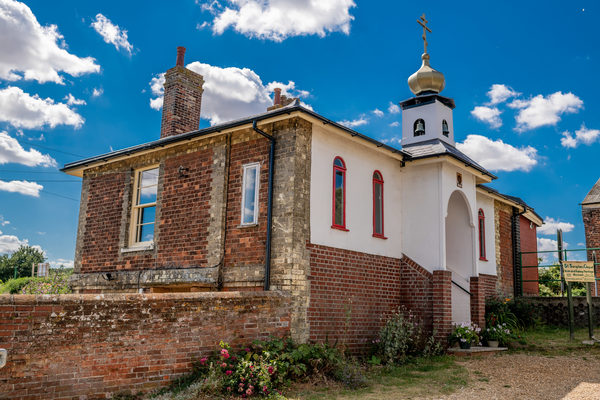This church was built in the 14C, probably about 1320 - 40, with the most attractive Decorated tracery in it nave windows. Walsingham Priory became the Patron of this church in 1315 and maybe was responsible for the building of a new church. The windows have curvilinear tracery, with double reticulation, or quatrefoils and trefoils within quatrefoils. The windows at the east ends of the aisles and the tower window are particularly fine. This tracery is so similar to that seen at Beeston next Mileham that it is likely that the same master builder and stone masons were involved with both churches. Further quatrefoils are to be seen in the circular clerestory windows, seven each side above the aisles. The original church site before the 14C was a bit further to the north. A separate church dedicated to All Saints was only about 250 yards to the north-east of St Peter's, but this went out of use just before 1522. Low remains of its walls can still be seen in the meadow.
The tower is also of the 1300s, although the belfry openings have simpler tracery with just a single quatrefoil in their heads. It is topped by a plain parapet, and has large buttresses to the west. The tower stair turret climbs the southeast corner to the silence chamber below the belfry, which has small single light openings. In the belfry are the original three bells, cast by William Silisden of King's Lynn, probably between 1330 - 50 from their design. They were rehung by Taylor of Loughborough in 1976 for fixed chiming on steel joists. The original timber frame was re-built round the bells.
The chancel has been allowed to become ruinous, probably in the 16C, but some of its north and south walls remain. A south window indicates that it had similar tracery to the nave and the chancel was therefore built in the 14C. The chancel arch was infilled and provided with two square headed windows, one above the other. The inverted V of stone shows where the original roof line was.
The south porch was added in the 15C and has chequered flushwork in its parapet. The south face has two fine stone statue niches, with delicate vaulting inside their trefoil heads. The south doorway has many fine mouldings around its arch and headstops finish the hood mould. On the north side of the church a vestry was added in 1860 to match the south porch, except for having a window in its north wall instead of the south's entrance.
Entering the church it is immediately apparent that the main altar is within the nave, which including the two aisles is almost square. Behind the high altar the former chancel arch has been infilled, though a curious line of beam ends suggests that the wall was built around the supports for the rood beam. There are two simple square-headed windows in this new wall. The tall chancel arch and the tower arch are of the same pattern as the arcades, which have three pillars each side. These are of a quatrefoil plan with a flat fillet to each curve and more fillets between the curves. Above the arches are the fine clerestory windows, with the light coming in through the quatrefoils as it did when this church was built in the 14C. On the south nave wall is a wall painting of a consecration cross, (one of originally twelve when the church was consecrated), and also parts of black letter texts. The fine windows still retain fragments of the original 14C medieval glass in the tracery lights. The most interesting is in the east window of the north aisle where grotesques fill the smaller openings and two larger ones show the heads and hands of the Blessed Virgin Mary, her hands together in prayer, and Christ with His right hand raised in blessing. These represent the Coronation of the Virgin. The south aisle's east window has two saint's heads, probably Apostles, and a north nave window has a small figure of Christ displaying His wounds. Near the tower arch is a brightly painted red, black and gold 19C organ, protected by cupboard doors, now replaced in services by a modern electric version. The 15C font, against the north-west pillar, has trefoil headed panels around its bowl, and the Jacobean font cover has a colourful canopy on eight legs with a gold chevron pattern. Above the north door are displayed the Hanoverian Arms of George I, 1717 -1727, clearly showing the motto "DIEU ET MON DROIT". The fourth quarter has the two gold lions of Brunswick, the blue lion of Luneberg and the white horse of Hanover, with the crown of Charlemagne in the centre.
The benches in this church are one of the finest remaining sets from the 15C, though somewhat battered through the ages. Many have open carvings of tracery in their backs and there are linen fold panels at the front and back of the pews. The poppy heads include deep foliaged carvings, some clearly depicting vines or oaks. One poppy head in the centre nave is thought maybe to be a medieval representation of Our Lady of Walsingham. In the south aisle are grotesques and also angels with shields, and in the north aisle on the arm rests are a series of six recognisable standing Apostles, Saints Andrew (X), Simon (saw), John the Evangelist (chalice), James the Less (fuller's club), Matthew (money bag) and Bartholomew (flaying knife). At the east end of the central pews stands a poor box, an oak post covered with iron work and secured with three locks. These came into use after the Reformation when the monasteries were dissolved so the churches had to provide for the poor and destitute, instead of the monks doing this work. Further woodwork is to be seen in the pulpit, now elevated on a stand and approached by steps. It has carved decorated tracery on its panels and probably a later date of restoration of "I.E.M.1613" painted on two small shields.
The high altar is possibly a country-made version Jacobean-work with cup and cover mouldings on its legs, sturdy stretcher rails and a carved frieze along its top rail. It is protected by a row of altar rails with turned balusters. Each aisle also has its own altar, with its own medieval piscina. The south altar has a modern painted reredos showing the Blessed Virgin Mary and Child accompanied by angels and supported by two saints either side including John the Baptist and Mary Magdalene. The rood stairs are still there within the stonework of the east end of the south arcade, with both doorways. The centre aisle contains two brass inscriptions, to the north for Elizabeth Alee +1641, ending with "Heaven has her soule, this earth her earth, her love her husband keeps. The ods twixt him and her is breth, Which gon all flesh thus sleeps", and to the south for Jane Golding +1632, ending "Sober, Meeke, Patient, Modest, Constant halted, Her soule remaines in blysse, in peace departed"! A further inscription for Robert Marcall +1593 lies near the pulpit.








